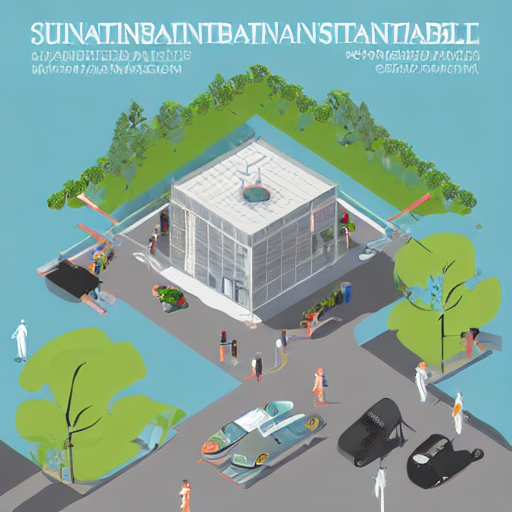
Post written by \ Yasser Mokhtar Osman 09/15/2023
Hello ECHO Friends
Our New Subject for today is Understanding the Role of Sustainability in Architecture and Design
Overview
Definition of sustainability
Sustainability in architecture and design refers to the practice of creating buildings and spaces that minimize negative environmental impacts and promote long-term social and economic well-being. It involves considering the entire lifecycle of a building, from its design and construction to its operation and eventual demolition or reuse. Sustainable architecture and design prioritize energy efficiency, water conservation, waste reduction, and the use of environmentally friendly materials. By integrating sustainable practices into the built environment, architects and designers can contribute to a more sustainable future, where buildings and spaces are not only aesthetically pleasing but also environmentally responsible.
Importance of sustainability in architecture and design
The importance of sustainability in architecture and design cannot be overstated. In today’s world, where climate change and environmental degradation are major concerns, it is crucial for architects and designers to prioritize sustainable practices. Sustainable architecture and design aim to minimize the negative impact on the environment while maximizing energy efficiency and resource conservation. By incorporating sustainable materials, renewable energy sources, and green building techniques, architects and designers can create buildings that not only benefit the environment but also enhance the well-being of the occupants. Moreover, sustainable design promotes a more holistic approach to architecture, considering not only the physical aspects but also the social and economic implications. It is through sustainable practices that we can create a built environment that is not only aesthetically pleasing but also resilient and harmonious with the natural world.
Historical context of sustainability in architecture and design
In order to understand the role of sustainability in architecture and design, it is important to explore its historical context. Sustainability in architecture and design has its roots in ancient civilizations, where people built structures in harmony with nature and utilized local materials. The concept of sustainable design gained prominence during the industrial revolution, as architects and designers began to recognize the negative impact of mass production and urbanization on the environment. This led to the emergence of movements such as the Arts and Crafts movement and the Bauhaus, which emphasized the integration of design and sustainability. Today, sustainability has become a fundamental principle in architecture and design, with architects and designers striving to create buildings and spaces that minimize environmental impact and promote social well-being.
Sustainable Materials and Construction Techniques
Use of renewable materials
The use of renewable materials is a key aspect in sustainable architecture and design. By incorporating materials that can be replenished naturally, such as bamboo, wood, and recycled materials, architects and designers can minimize the environmental impact of their projects. Renewable materials not only reduce the consumption of finite resources but also contribute to the reduction of greenhouse gas emissions. Additionally, these materials often have a lower carbon footprint compared to traditional building materials, making them a more sustainable choice. The use of renewable materials in architecture and design not only promotes environmental stewardship but also creates healthier and more resilient built environments.
Energy-efficient construction techniques
Energy-efficient construction techniques play a crucial role in sustainable architecture and design. These techniques focus on reducing energy consumption and minimizing environmental impact throughout the construction process. One popular technique is the use of insulation materials that provide better thermal performance, allowing buildings to maintain comfortable indoor temperatures without excessive use of heating or cooling systems. Additionally, incorporating passive design strategies such as strategic placement of windows and shading devices can maximize natural light and ventilation, reducing the need for artificial lighting and air conditioning. Furthermore, the integration of renewable energy sources, such as solar panels or wind turbines, can help generate clean and sustainable energy for the building. By implementing these energy-efficient construction techniques, architects and designers can create buildings that not only reduce energy consumption but also contribute to a more sustainable future.
“الاجتهاد والاتزام والمثابرة وحب العمل هو احد اسباب نجاح اي شخص في مجال الاعمال “
ياسر مختار عثمان
Waste reduction and recycling in construction
Waste reduction and recycling in construction plays a crucial role in promoting sustainability in architecture and design. Design Agency is one of the key players in this field, actively working towards minimizing waste and maximizing recycling in construction projects. With their innovative approaches and expertise, Design Agency has been able to implement sustainable practices that not only reduce environmental impact but also contribute to the overall efficiency of the construction process. By incorporating waste reduction strategies and encouraging the use of recycled materials, Design Agency is setting a new standard for sustainable architecture and design.
Energy Efficiency in Building Design
Passive design strategies
Passive design strategies play a crucial role in creating sustainable and energy-efficient buildings. These strategies aim to maximize natural resources such as sunlight, wind, and shade to reduce the reliance on artificial heating, cooling, and lighting systems. By carefully considering factors such as building orientation, insulation, and ventilation, architects and designers can create spaces that are comfortable, healthy, and environmentally friendly. Passive design strategies not only reduce energy consumption and greenhouse gas emissions but also contribute to the overall well-being of the occupants. With an increasing focus on sustainability, incorporating passive design strategies has become an essential aspect of modern architecture and design.
Integration of renewable energy sources
The integration of renewable energy sources is a crucial aspect in the field of architecture and design. With the growing concern for environmental sustainability, architects and designers are increasingly incorporating renewable energy technologies into their projects. This integration not only helps reduce the reliance on fossil fuels but also contributes to the overall energy efficiency of buildings. Solar panels, wind turbines, and geothermal systems are some of the commonly used renewable energy sources in architecture. By harnessing the power of the sun, wind, and the earth’s heat, buildings can generate clean and sustainable energy, reducing their carbon footprint and promoting a greener future. The integration of renewable energy sources in architecture and design is a testament to the industry’s commitment to creating sustainable and eco-friendly built environments.
Smart building technologies
Smart building technologies play a crucial role in advancing sustainability in architecture and design. These technologies integrate various systems and components to optimize energy efficiency, reduce waste, and enhance occupant comfort. From automated lighting and HVAC systems to intelligent sensors and controls, smart building technologies enable buildings to adapt and respond to changing environmental conditions. By leveraging data and analytics, these technologies enable architects and designers to make informed decisions that minimize the environmental impact of buildings while maximizing their performance and functionality. With the increasing emphasis on sustainability, smart building technologies are becoming an essential aspect of modern architecture and design.
Image Related
Biophilic Design and Connection to Nature
Incorporation of natural elements in design
Incorporation of natural elements in design is a fundamental aspect of sustainable architecture and design. By integrating elements such as sunlight, water, and vegetation, architects and designers can create spaces that not only provide aesthetic appeal but also promote environmental sustainability. Natural light, for example, can be maximized through strategic placement of windows and skylights, reducing the need for artificial lighting and lowering energy consumption. Similarly, incorporating water features like rainwater harvesting systems and green roofs can help conserve water resources and mitigate stormwater runoff. The use of vegetation in design not only enhances the visual appeal of a space but also contributes to improved air quality and biodiversity. By consciously incorporating these natural elements into the design process, architects and designers can create sustainable spaces that prioritize the well-being of both the environment and its occupants.
Benefits of biophilic design
Biophilic design, also known as nature-inspired design, is an approach that incorporates natural elements and patterns into architectural and interior design. This design philosophy recognizes the innate human connection to nature and aims to create spaces that promote health and well-being. There are several benefits of biophilic design. Firstly, it has been found to improve air quality and reduce the presence of harmful pollutants in indoor environments. Additionally, biophilic design has been shown to enhance cognitive function and productivity, as well as reduce stress and promote relaxation. Furthermore, incorporating biophilic elements such as plants, natural light, and water features can create a sense of harmony and connection with the natural world. Overall, biophilic design offers numerous advantages in terms of creating sustainable and healthy built environments.
Creating a connection to nature in urban environments
In today’s rapidly urbanizing world, it is becoming increasingly important to create a connection to nature in urban environments. As cities expand and green spaces become limited, architects and designers are faced with the challenge of integrating nature into the built environment. This not only enhances the aesthetic appeal of urban spaces but also has numerous benefits for the well-being of city dwellers. By incorporating elements such as rooftop gardens, vertical green walls, and urban parks, architects can provide residents with access to nature, improving air quality, reducing noise pollution, and promoting physical and mental health. Additionally, these sustainable design strategies help mitigate the negative environmental impact of urbanization, contributing to a more sustainable and resilient future for our cities.
Social and Cultural Impacts of Sustainable Architecture
Improving quality of life
Improving quality of life is a key objective in the field of architecture and design. Sustainability plays a crucial role in achieving this goal by promoting practices that minimize negative impacts on the environment and prioritize the well-being of individuals and communities. By incorporating sustainable design principles, such as energy-efficient systems, natural lighting, and green spaces, architects and designers can create spaces that enhance the physical, mental, and emotional well-being of the occupants. These sustainable practices not only contribute to a healthier and more comfortable living environment but also foster a sense of community and connection to nature, ultimately improving the overall quality of life for individuals and society as a whole.
Promoting community engagement
Promoting community engagement is a crucial aspect of incorporating sustainability in architecture and design. By involving the local community in the decision-making process, architects and designers can ensure that their projects align with the needs and values of the people who will be using them. This not only enhances the overall quality of the design but also fosters a sense of ownership and pride among community members. Additionally, community engagement allows for the exchange of ideas and knowledge, leading to innovative and sustainable solutions that address the specific challenges and opportunities of the local context. By promoting community engagement, architects and designers can create spaces that not only meet the functional requirements but also contribute to the social, cultural, and environmental well-being of the community.
Preserving cultural heritage
Preserving cultural heritage is a crucial aspect of sustainable architecture and design. It involves the conservation and protection of historical buildings, sites, and artifacts that hold significant cultural value. By incorporating sustainable practices into the preservation of cultural heritage, we can ensure the longevity of these precious assets for future generations. This includes implementing energy-efficient technologies, using environmentally friendly materials, and promoting adaptive reuse to minimize waste and carbon footprint. Preserving cultural heritage not only safeguards our history and identity but also contributes to the overall sustainability of our built environment.
Conclusion
Summary of key points
In summary, sustainability plays a crucial role in architecture and design. It involves creating structures and spaces that are environmentally friendly, energy-efficient, and socially responsible. Sustainable architecture and design aim to minimize the negative impact on the environment while maximizing the benefits for both the users and the surrounding community. This approach considers the use of sustainable materials, efficient use of resources, and the integration of renewable energy sources. By incorporating sustainable practices, architects and designers can create buildings and spaces that not only meet the needs of the present but also contribute to a more sustainable future.
Future prospects of sustainability in architecture and design
The future prospects of sustainability in architecture and design are promising. As the world continues to grapple with the effects of climate change and the depletion of natural resources, sustainable practices in architecture and design have become increasingly important. Architects and designers are now incorporating sustainable materials, energy-efficient systems, and eco-friendly design principles into their projects. This not only helps reduce the environmental impact of buildings but also creates healthier and more comfortable spaces for occupants. Additionally, the growing demand for sustainable buildings and the implementation of green building codes and certifications further drive the adoption of sustainable practices. With ongoing advancements in technology and a growing awareness of the need for sustainable solutions, the future of sustainability in architecture and design looks bright.
Call to action for architects and designers
As architects and designers, it is our responsibility to prioritize sustainability in our work. The future of our planet depends on it. By incorporating sustainable practices and materials into our designs, we can minimize the negative impact on the environment and create spaces that are not only aesthetically pleasing but also environmentally friendly. It is time for us to take action and make a difference. Let us commit to designing buildings and spaces that are energy-efficient, promote renewable energy sources, and prioritize the use of recycled materials. Together, we can create a more sustainable future for generations to come.
من فضلك شارك الموضوع مع الاخرين
Please Share the post with others
- Architectural Landmarks
- Architectural


